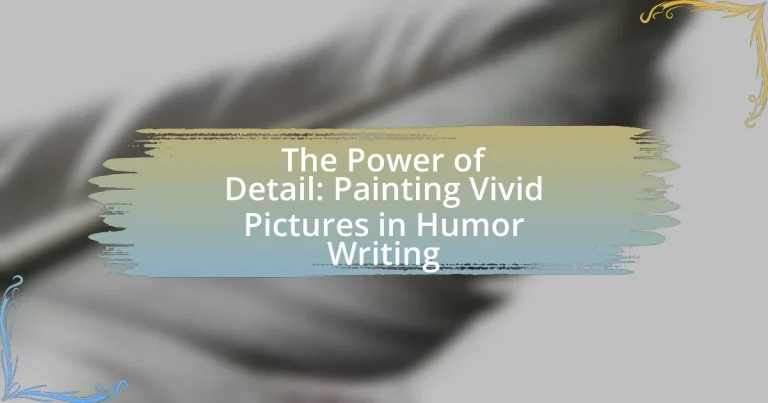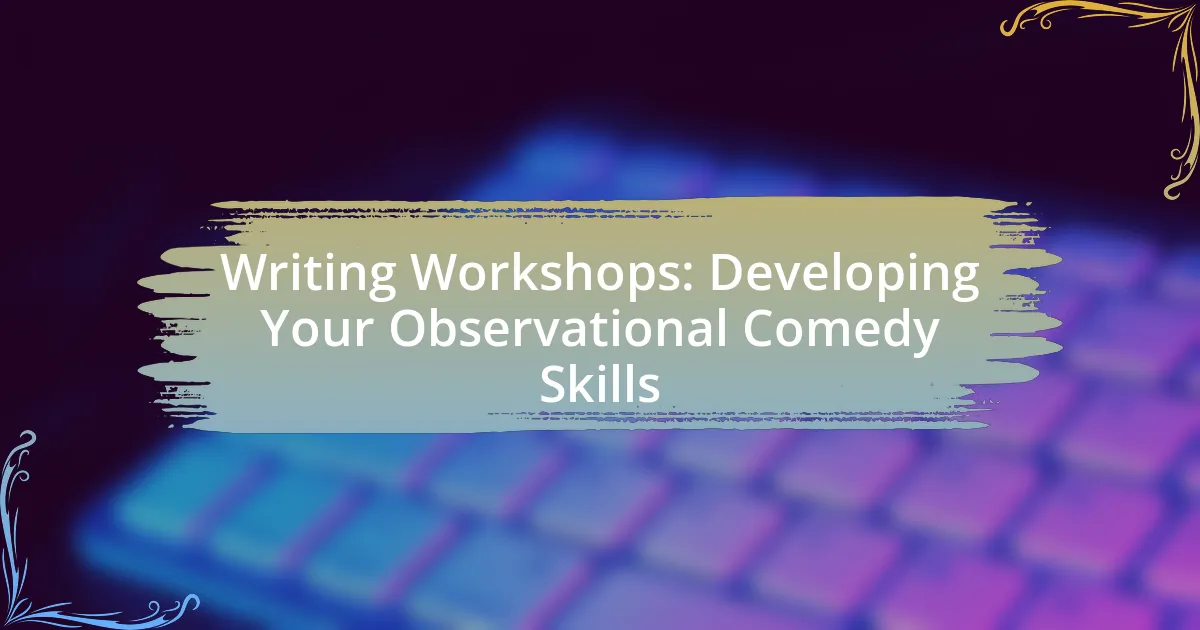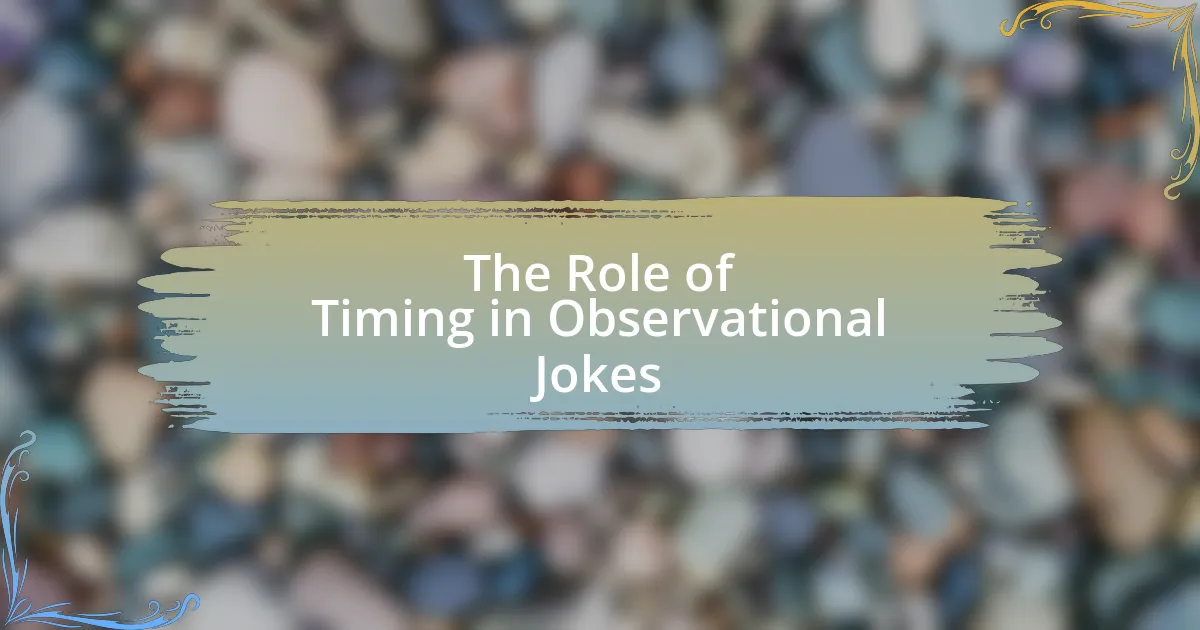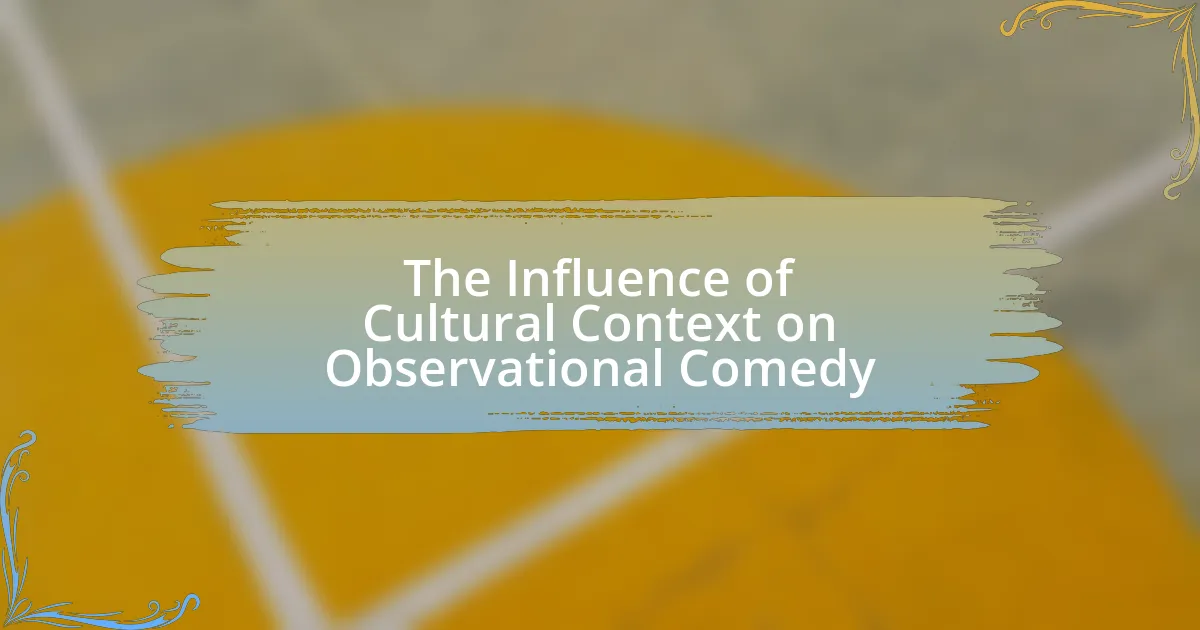The article titled “The Power of Detail: Painting Vivid Pictures in Humor Writing” explores the significance of detail in enhancing humor through vivid imagery and relatability. It discusses how specific details, such as exaggeration and absurdity, amplify comedic effects and engage readers by allowing them to visualize scenarios. The article also examines the role of sensory details in creating emotional connections, the importance of balancing detail with brevity, and the distinctions between different humor styles, including observational and slapstick humor. Additionally, it highlights common pitfalls in humor writing and offers practical tips for effectively incorporating detail to improve comedic impact.
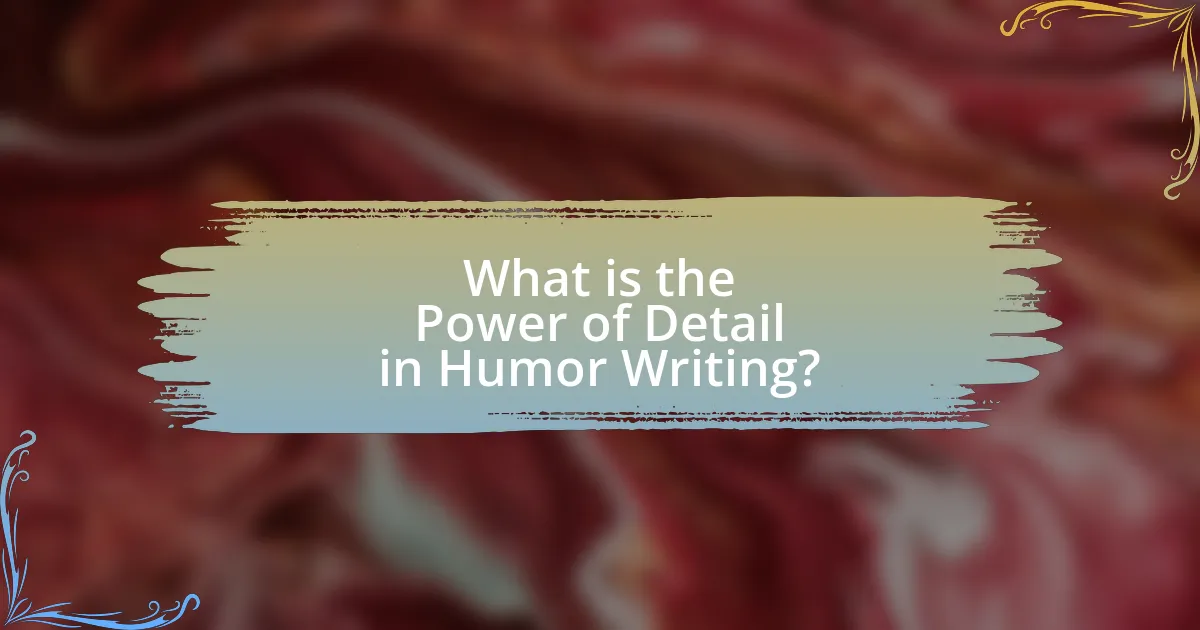
What is the Power of Detail in Humor Writing?
The power of detail in humor writing lies in its ability to create vivid imagery and enhance relatability, making the humor more impactful. Specific details allow readers to visualize scenarios, characters, and emotions, which amplifies the comedic effect. For instance, a well-crafted description of a character’s exaggerated traits can evoke laughter by highlighting absurdity, as seen in the works of authors like David Sedaris, who often uses meticulous details to draw readers into his humorous narratives. This technique not only engages the audience but also fosters a deeper connection to the humor, as readers can see themselves in the situations described.
How does detail enhance humor in writing?
Detail enhances humor in writing by creating vivid imagery that allows readers to visualize and connect with the comedic elements. When writers incorporate specific details, such as unique character traits or situational quirks, they amplify the absurdity of the scenario, making the humor more relatable and impactful. For instance, a character described as wearing mismatched socks and a polka-dot tie can evoke laughter by highlighting their eccentricity, which contrasts with societal norms. This technique is supported by studies in humor theory, such as the Incongruity Theory, which posits that humor arises from the juxtaposition of unexpected elements, further emphasizing how detail can enhance comedic effect.
What specific types of details contribute to comedic effect?
Specific types of details that contribute to comedic effect include exaggeration, incongruity, and absurdity. Exaggeration amplifies characteristics or situations to an unrealistic degree, making them humorous; for example, describing a character as having a “voice that could shatter glass” emphasizes their loudness in a comedic way. Incongruity arises when there is a mismatch between expectations and reality, such as a serious character in a silly situation, which creates humor through surprise. Absurdity involves illogical or nonsensical elements, like a talking dog giving life advice, which can evoke laughter due to its sheer ridiculousness. These details are effective because they disrupt normal patterns of thought, leading to unexpected and humorous outcomes.
How do sensory details influence the reader’s experience?
Sensory details significantly enhance the reader’s experience by creating vivid imagery that engages the senses. When a writer incorporates sensory details—such as sights, sounds, tastes, textures, and smells—it allows readers to immerse themselves in the narrative, making the experience more relatable and emotionally resonant. For instance, a study published in the journal “Cognitive Science” by authors H. M. Kosslyn and J. M. Thompson demonstrates that sensory-rich descriptions can activate brain areas associated with perception, leading to a more profound connection with the text. This engagement not only aids in visualization but also evokes emotions, making the humor more impactful and memorable.
Why is vivid imagery important in humor writing?
Vivid imagery is important in humor writing because it enhances the reader’s ability to visualize and emotionally connect with the comedic elements. By creating detailed and striking mental pictures, humor writers can amplify the absurdity or irony of a situation, making the humor more impactful. Research indicates that humor often relies on incongruity, and vivid imagery helps to establish a clear context that highlights this incongruity, thereby increasing the likelihood of eliciting laughter. For example, a study published in the Journal of Humor Research found that descriptive language significantly improved the comedic effect of jokes by engaging the audience’s imagination and emotions.
What role does imagery play in setting the tone of a humorous piece?
Imagery plays a crucial role in setting the tone of a humorous piece by creating vivid mental pictures that enhance comedic effects. When writers use descriptive language, they evoke specific emotions and reactions from the audience, making the humor more relatable and engaging. For instance, exaggerated imagery can amplify absurdity, leading to heightened comedic impact, as seen in works by authors like Douglas Adams, who employs surreal imagery to elicit laughter. This connection between imagery and humor is supported by studies in literary analysis, which indicate that detailed descriptions can significantly influence a reader’s emotional response, thereby shaping the overall tone of the piece.
How can imagery evoke emotions that enhance humor?
Imagery can evoke emotions that enhance humor by creating vivid mental pictures that resonate with the audience’s experiences and feelings. When humor incorporates detailed imagery, it allows individuals to visualize scenarios, making them more relatable and engaging. For instance, a comedic description of a clumsy character slipping on a banana peel not only paints a clear picture but also elicits laughter through the shared understanding of physical comedy. Research indicates that humor often relies on incongruity, and imagery can amplify this by contrasting expectations with surprising details, thereby intensifying the emotional response.
What techniques can writers use to incorporate detail effectively?
Writers can incorporate detail effectively by using sensory descriptions, specific imagery, and character-driven anecdotes. Sensory descriptions engage readers by appealing to sight, sound, taste, touch, and smell, creating a vivid experience. For instance, instead of stating “the cake was delicious,” a writer might describe “the rich chocolate cake, with its velvety frosting and a hint of espresso, melting in the mouth.” Specific imagery enhances clarity and allows readers to visualize scenes more vividly, as seen in the phrase “the sun dipped below the horizon, painting the sky in hues of orange and purple.” Character-driven anecdotes provide personal insights and relatable experiences, making details resonate more deeply with the audience. For example, sharing a humorous mishap during a family gathering can evoke laughter while painting a detailed picture of the event. These techniques collectively enrich the narrative, making it more engaging and memorable for readers.
How does the use of metaphors and similes improve humor writing?
The use of metaphors and similes enhances humor writing by creating vivid imagery that engages readers and evokes laughter. These literary devices allow writers to draw unexpected comparisons, making situations more relatable and absurd, which amplifies comedic effect. For instance, describing a chaotic scene as “like a cat in a room full of rocking chairs” not only paints a clear picture but also adds an element of surprise and humor through the absurdity of the comparison. Research indicates that humor often relies on incongruity, and metaphors and similes effectively highlight this by juxtaposing familiar concepts with unexpected twists, thereby enriching the comedic narrative.
What are the best practices for balancing detail and brevity?
The best practices for balancing detail and brevity involve focusing on essential information while eliminating unnecessary words. Writers should prioritize clarity by using concise language that conveys the core message without superfluous details. For instance, employing strong verbs and specific nouns can enhance imagery while maintaining brevity. Additionally, writers can utilize techniques such as summarizing complex ideas into key points and using bullet lists to present information succinctly. Research indicates that effective communication often relies on the principle of “less is more,” where clarity and impact are achieved through simplicity, as supported by studies in cognitive load theory which suggest that excessive detail can overwhelm readers and hinder comprehension.
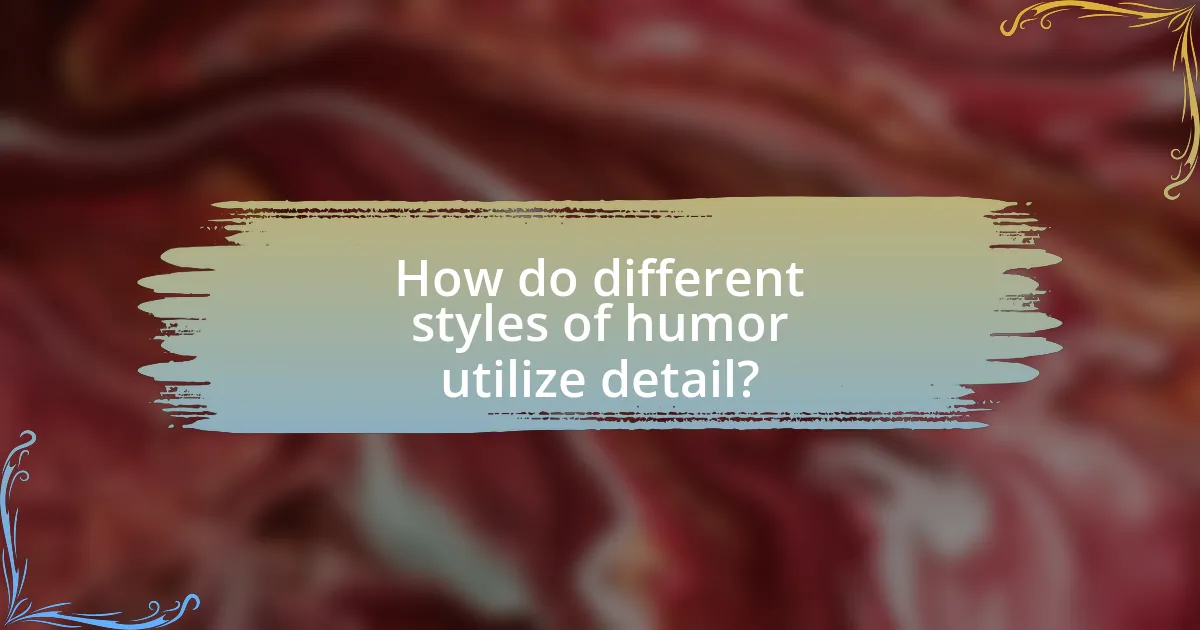
How do different styles of humor utilize detail?
Different styles of humor utilize detail to enhance comedic effect and create vivid imagery. For instance, observational humor relies on specific, relatable details from everyday life to connect with the audience, making the humor more impactful. In contrast, absurdist humor often employs exaggerated or surreal details that defy logic, creating a sense of surprise and confusion that elicits laughter. Furthermore, character-driven humor uses intricate details about personalities and quirks to build relatable or exaggerated characters, which amplifies the comedic situations they find themselves in. Research indicates that humor that incorporates rich detail is more likely to engage audiences, as it allows them to visualize scenarios and relate to the content on a personal level.
What are the distinctions between observational and slapstick humor in terms of detail?
Observational humor focuses on relatable, everyday situations and nuances, while slapstick humor relies on physical comedy and exaggerated actions. Observational humor often includes detailed observations about human behavior, social norms, and mundane experiences, allowing audiences to connect through shared experiences. For example, comedians like Jerry Seinfeld excel in this style by highlighting the absurdities of daily life, such as waiting in line or dealing with technology. In contrast, slapstick humor emphasizes visual gags, physical mishaps, and absurd scenarios, often devoid of intricate detail in dialogue. Classic examples include the antics of Charlie Chaplin or the Three Stooges, where humor arises from exaggerated physicality rather than nuanced commentary. Thus, the distinction lies in observational humor’s reliance on detailed social commentary versus slapstick’s focus on visual and physical exaggeration.
How does observational humor rely on relatable details?
Observational humor relies on relatable details by drawing on shared experiences that resonate with a wide audience. This type of humor often highlights everyday situations, behaviors, or quirks that people encounter in their lives, making the content accessible and engaging. For instance, comedians frequently reference common scenarios like waiting in line or dealing with technology failures, which evoke familiarity and prompt laughter due to the recognition of these universal experiences. Research indicates that humor is more effective when it connects with the audience’s personal experiences, as seen in studies on social cognition that show how shared knowledge enhances comedic impact.
What types of details are essential for effective slapstick humor?
Effective slapstick humor relies on physicality, timing, and exaggerated actions. Physicality involves the use of visual gags, such as pratfalls or exaggerated movements, which create a strong visual impact. Timing is crucial, as the delivery of a joke or action must be perfectly synchronized to elicit laughter; for instance, a well-timed pie-in-the-face moment can be hilarious. Exaggerated actions amplify the absurdity of situations, making them more humorous; for example, a character slipping on a banana peel in an exaggerated manner enhances the comedic effect. These elements are essential because they engage the audience’s visual and emotional responses, making the humor more effective.
How does cultural context influence the use of detail in humor?
Cultural context significantly influences the use of detail in humor by shaping the references, norms, and values that resonate with an audience. For instance, humor that relies on specific cultural idioms or social practices may be understood and appreciated only within that cultural framework, while details that are humorous in one culture may be confusing or offensive in another. Research indicates that humor often reflects societal values; for example, a study by Martin and Ford (2018) in the Journal of Humor Research highlights how cultural background affects humor appreciation, demonstrating that culturally relevant details enhance relatability and comedic impact. Thus, the effectiveness of humor is closely tied to the cultural context in which it is presented, as it determines the shared knowledge and experiences that inform the audience’s understanding of the details used.
What specific cultural references can enhance humor through detail?
Specific cultural references that can enhance humor through detail include iconic television shows, popular movies, and well-known historical events. For instance, referencing “Friends” can evoke nostalgia and shared experiences among audiences familiar with the show’s humor and character dynamics. Similarly, mentioning classic films like “The Godfather” can create comedic moments by juxtaposing serious themes with absurd scenarios, as seen in parodies. Historical events, such as the moon landing, can also serve as a backdrop for humor by allowing writers to play with the contrast between the monumental achievement and the mundane aspects of everyday life. These references resonate with audiences, making the humor more relatable and impactful.
How do different audiences perceive details in humor writing?
Different audiences perceive details in humor writing based on their cultural backgrounds, personal experiences, and familiarity with the humor style. For instance, research indicates that humor appreciation varies significantly across demographics; a study by Martin et al. (2003) found that individuals from different cultural contexts interpret humor differently, affecting their understanding of specific details. Additionally, audiences with a shared experience or knowledge of a particular subject are more likely to find humor in nuanced details related to that subject, as evidenced by the concept of in-group humor, which relies on shared references for comedic effect. Thus, the perception of details in humor writing is heavily influenced by the audience’s context and background.
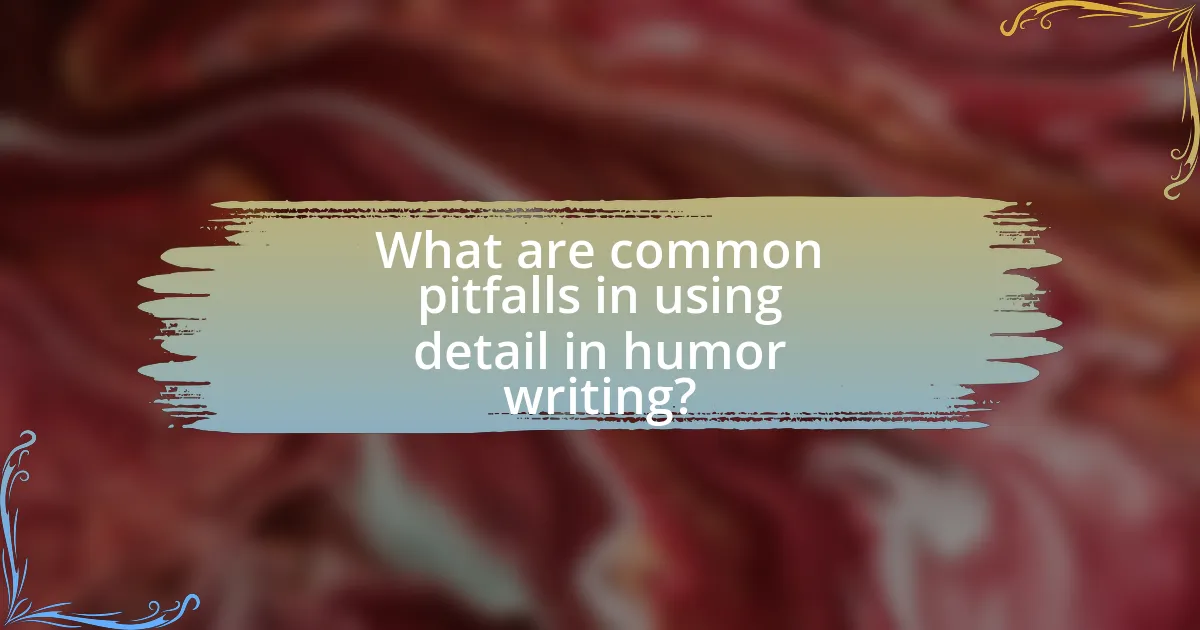
What are common pitfalls in using detail in humor writing?
Common pitfalls in using detail in humor writing include over-explaining, which can dilute the punchline, and excessive specificity that may alienate the audience. Over-explaining occurs when a writer elaborates too much on a joke, leading to a loss of comedic timing and impact. For instance, a simple setup can become tedious if filled with unnecessary background information. Excessive specificity can also hinder humor; if a detail is too niche or obscure, it may not resonate with a broader audience, resulting in confusion rather than laughter. Balancing detail is crucial, as effective humor often relies on brevity and relatability.
How can excessive detail detract from humor?
Excessive detail can detract from humor by overwhelming the audience and obscuring the punchline. When humor relies on brevity and timing, too much elaboration can lead to confusion or loss of interest, causing the comedic effect to diminish. For instance, a study by the University of California found that jokes with concise setups were more likely to elicit laughter compared to those laden with unnecessary specifics. This indicates that while detail can enhance imagery, it must be balanced to maintain comedic impact.
What are the signs that detail is overwhelming the punchline?
Signs that detail is overwhelming the punchline include excessive elaboration that distracts from the humor, loss of pacing that causes the audience to lose interest, and a lack of clarity where the main joke becomes obscured by unnecessary information. When humor writing becomes bogged down by intricate descriptions or tangents, the intended punchline may fail to land effectively. For instance, if a joke requires multiple sentences of setup that do not directly contribute to the humor, the audience may forget the punchline by the time it arrives. This phenomenon is supported by comedic theory, which emphasizes the importance of timing and brevity in delivering effective humor.
How can writers identify when to cut unnecessary details?
Writers can identify when to cut unnecessary details by evaluating whether each detail serves a specific purpose in advancing the plot, developing characters, or enhancing the humor. If a detail does not contribute to these elements, it is likely extraneous. For instance, a study by the University of Southern California found that concise writing improves reader engagement, indicating that unnecessary details can detract from the overall impact of the narrative. Therefore, writers should regularly assess the relevance and effectiveness of details in their work to maintain clarity and focus.
What strategies can help avoid these pitfalls?
To avoid pitfalls in humor writing, writers should focus on specificity, clarity, and audience awareness. Specificity enhances humor by providing vivid details that create relatable scenarios, making the humor more impactful. Clarity ensures that the intended joke or humorous point is easily understood, preventing confusion that can dilute the comedic effect. Audience awareness allows writers to tailor their humor to the preferences and sensibilities of their target demographic, increasing engagement and resonance. Research indicates that humor is more effective when it aligns with the audience’s cultural context and experiences, as highlighted in the study “The Role of Humor in Communication” by Robert M. Krauss and others, which emphasizes the importance of context in humor effectiveness.
How can feedback from peers improve the use of detail in humor writing?
Feedback from peers can significantly enhance the use of detail in humor writing by providing diverse perspectives on what resonates with audiences. When writers receive constructive criticism, they can identify areas where details may be lacking or overly complex, allowing them to refine their descriptions for clarity and impact. For instance, peer feedback can highlight specific moments that evoke laughter or confusion, guiding writers to focus on details that enhance comedic timing and relatability. Research indicates that collaborative writing processes, such as peer reviews, lead to improved narrative quality and engagement, as seen in studies published in the Journal of Writing Research, which demonstrate that writers who engage with peers produce more vivid and effective content.
What role does revision play in refining details for comedic impact?
Revision is crucial in refining details for comedic impact as it allows writers to enhance timing, clarity, and punchlines. Through the revision process, humorists can identify and eliminate unnecessary words, ensuring that each detail contributes to the overall comedic effect. For instance, a study by the University of Southern California found that precise wording and well-structured setups significantly increase audience laughter. By revising, writers can also experiment with different phrasings and structures, optimizing the delivery of jokes to maximize their effectiveness. This iterative process ultimately sharpens the humor, making it more relatable and engaging for the audience.
What practical tips can enhance the use of detail in humor writing?
To enhance the use of detail in humor writing, writers should focus on specificity, sensory language, and character quirks. Specificity allows writers to create vivid images that resonate with readers, making the humor more relatable and impactful. For instance, instead of saying “the dog was big,” describing it as “a lumbering, drooling St. Bernard” paints a clearer picture. Sensory language engages readers by appealing to sight, sound, taste, touch, and smell, which can amplify comedic effects; for example, describing the smell of burnt toast can evoke a humorous memory. Additionally, incorporating unique character quirks adds depth and relatability, as seen in the works of authors like David Sedaris, who often highlights eccentricities that enhance comedic situations. These techniques collectively contribute to a richer, more engaging humor writing experience.
How can writers practice incorporating detail into their humor effectively?
Writers can practice incorporating detail into their humor effectively by using specific, vivid imagery that enhances the comedic elements of their writing. This can be achieved through techniques such as employing sensory details, which engage the reader’s senses and create a more immersive experience. For instance, instead of stating that a character is clumsy, a writer might describe the character tripping over a garden gnome while juggling three watermelons, which adds humor through absurdity and specificity. Research indicates that humor often relies on the unexpected, and detailed descriptions can create a stronger contrast between the ordinary and the absurd, making the punchline more impactful. By consistently integrating such details, writers can refine their comedic voice and enhance the overall effectiveness of their humor.
What exercises can help develop a keen eye for detail in humor writing?
To develop a keen eye for detail in humor writing, writers can engage in observational exercises, such as daily journaling of humorous observations from everyday life. This practice encourages writers to notice and record the nuances of situations, dialogue, and character interactions that can enhance comedic elements. Additionally, analyzing and rewriting existing humorous pieces can sharpen attention to detail by forcing writers to identify what makes the humor effective or ineffective. Research indicates that writers who actively practice these exercises improve their ability to incorporate vivid details, which is crucial for creating relatable and engaging humor.
